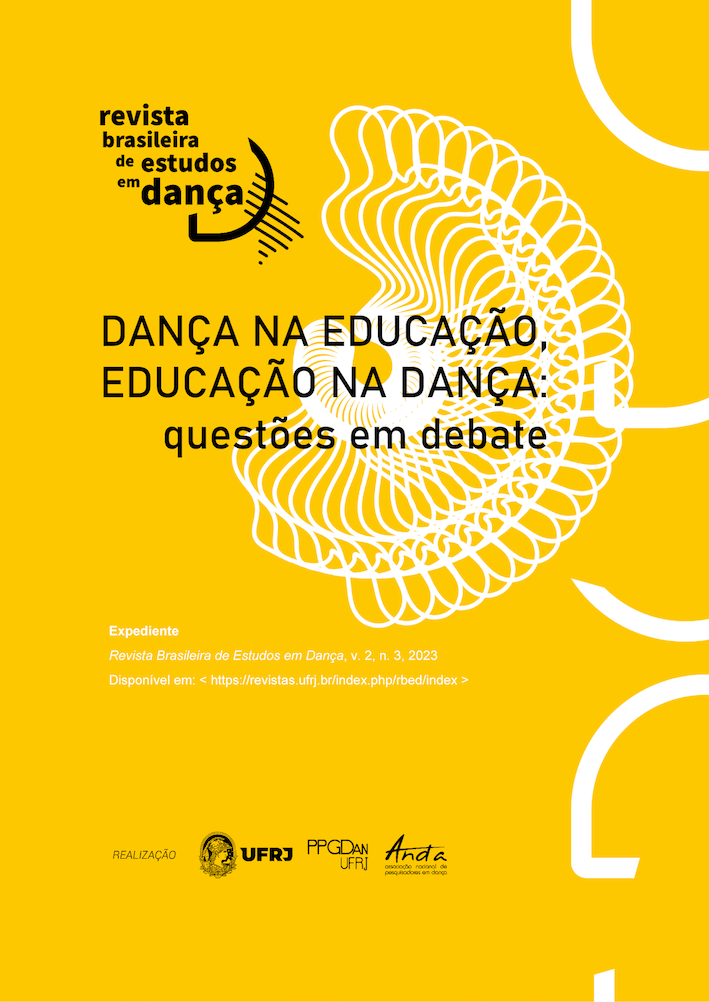The water cycle in the body:
a didactic dance sequence
DOI:
https://doi.org/10.58786/rbed.2023.v1.n3.59045Keywords:
dança na escola, educação, sequência didática, interdisciplinaridade, processo coreográficoAbstract
This article presents an example of a didactic Dance sequence, designed to establish interdisciplinary connections with Science content, carried out in the 3rd year of Elementary Education at a private school in São Paulo. Exploring the series axis, the sequence aimed to stimulate student authorship in the choreographic process. The description of this sequence was part of the master's dissertation entitled "Dance for Children in Education: rhythm, play, and imagination," supervised by Prof. Dr. Lilian Freitas Vilela, defended at IA of UNESP. The author grounded her professional practice in the Orff-Schulwerk approach and her experience as a dancer at Balangandança Cia
Downloads
References
HASELBACH, Barbara. Historia del Orff-Schulwerk. Revista Eletrônica Pesquiseduca, [S. l.], v. 2, n. 4, p. 321-332, 2012.
COSTA, Dailson, GONÇALVES, Tadeu. Compreensões, Abordagens, Conceitos e Definições de Sequência Didática na área de Educação Matemática. Bolema (Boletim de Educação Matemática), Rio Claro (SP), v. 36, n. 72, p.358-388, abr. 2022.
FIGUEIREDO, Flora Sipahi Pires Martins. Atelieristas: da célula atelier ao corpo atelier. 2015. Dissertação (Mestrado em Artes Visuais) – Instituto de Artes, Universidade Estadual Paulista "Júlio de Mesquita Filho”, São Paulo, 2015.
FREIRE, Paulo. Pedagogia do Oprimido. 50ª edição. Rio de Janeiro: Paz e Terra, 2018.
FREIRE, Paulo. Educação como prática da liberdade. Rio de Janeiro: Paz e Terra, 1967.
LARROSA, Jorge. Tremores: escritos sobre experiência. Tradução: João Wanderley Geraldi e Cristina Antunes. Belo Horizonte: Autêntica, 2014.
LÉVY, Pierre. As tecnologias da inteligência: o futuro do pensamento na era da informática. Tradução: Carlos Irineu da Costa. São Paulo: Editora 34, 1999.
LIB NEO, José Carlos. Didática. 2. ed. São Paulo: Cortez Editora, 2013.
MARQUES, Isabel. A. Dançando na Escola. São Paulo: Cortez, 2003.
ORFF, Carl. The Schulwerk. Tradução: Margaret Murray. Nova York: Schott Music, 1978. v. 3. (Carl Orff/Documentação).
SILVA, Andréa Fraga da. Dança para crianças. In: V FÓRUM - “forinho”: o brincar, a improvisação e a dança. São Paulo: Cia. Balangandança/Itaú Cultural, 2015.
SILVA, Andréa Fraga da.; PRADO, Patrícia Dias. Que danças criam as crianças? Arte e corporalidade na educação das infâncias. Educação Infantil: Comprometimento com a Formação Global da Criança. Atena, 2020.
SIMAS, Luiz Antônio; RUFINO, Luiz. Encantamento: sobre política de vida. Rio de Janeiro: Mórula, 2020.
VILELA, Lilian Freitas. Uma vida em dança: movimentos e percursos de Denise Stutz. 2010. Tese (Doutorado em Educação) – Faculdade de Educação, Universidade Estadual de Campinas, Campinas, 2010.
VILELA, Lilian Freitas. Encontros entre práticas: Bartenieff Fundamental 32 e Body-Mind Centering. Revista Brasileira de Estudos em Dança, ano 01, n. 02, p. 85-102, 2022.
WIGMAN, Mary. The Language of dance. Tradução: Walter Sorell. Connecticut: Wesleyan University Press Middletown, 1974.
WILHELM, Richard. I Ching: o livro das mutações. Tradução: Alzira Allegro. 7. ed. São Paulo: Pensamento, 2000.
XAVIER, Uxa. Que dança é essa? In: LENGOS, Georgia. (org.). Põe o dedo aqui: reflexões sobre dança contemporânea para crianças. São Paulo: Terceira Margem, 2007. p. 54-65.
Referências Musicais
Palavra Cantada. Água. No: Canções de Brincar. São Paulo: Sony Music, 2002.
Barbatuques. Peixinhos do Mar. No: Tum Pá. São Paulo: Independent, 2002.
Downloads
Published
Versions
- 2024-05-09 (3)
- 2023-12-01 (2)
- 2023-09-02 (1)
How to Cite
Issue
Section
License
Authors who publish in the Revista Brasileira de Estudos em Dança are
responsible for the content of signed articles and retain copyright.
They grant the journal the right of first publication with the work simultaneously
licensed under the Creative Commons Attribution-NonCommercial 4.0 License
(Open Archives Initiative - OAI). This feature, used for open-access journals,
allows sharing work for non-commercial purposes and acknowledges
authorship. If the text is later published in another vehicle, the author
must inform that it was initially published as an article in the Revista Brasileira
de Estudos em Dança. Therefore, even if the journal owns the first publication,
authors are entitled to publish their work in institutional repositories or on
their personal pages, even if the editorial process has not been completed.
The journal reserves the right to make normative, orthographic, and grammatical changes to maintain the language standard, respecting the authorial style.

